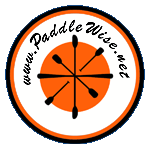| PaddleWise
Topics
PaddleWise Stories PaddleWise Photo Album |
 |
Who's Who on PaddleWise
PaddleWise Links PaddleWise Home |
| PaddleWise
Topics
PaddleWise Stories PaddleWise Photo Album |
 |
Who's Who on PaddleWise
PaddleWise Links PaddleWise Home |
Date: Sat, 5 Feb 2000 11:09:20 +0900 (KST) From: David Kosofsky Subject: [Paddlewise] Hypalon Skin/Hull Repair Questions An unplanned and unfortunate encounter with a sharp submerged rock while paddling my Feathercraft K-Light down the Ocissa River near Tallahassee this afternoon has me suddenly interested in the details of the technique for repairing a small hole in a hypalon skin. I have the Feathercraft-supplied kit: glue, hypalon patches and somewhat laconic instructions. I'm left with the following questions: 1) Is it better to repair the skin when it is stretched (i.e., when the kayak is assemble) or when it is loose (i.e. off the frame entirely)? 2) Would it make sense to patch the hole from the INSIDE (in the interest of avoiding a hydrodynamics-impairing external patch) or would that leave the external wound liable to be enlarged? 3) Assuming the patch is done from the outside, what can be done to minimize the deformation of the hull's smoothness. That is, how can the patch be made to blend with the contour of the hull? 4) Any other bits of advice (other than, "ALWAYS BRING DUCT-TAPE," which will be my mantra from now on)? Thanks, David Kosofsky ps-- Lest this be construed as criticism of Feathercraft, of hypalon, or of folding kayaks, let me hasten to mention that of MANY unplanned encounters with rocks, coral-reefs, etc., this is the first to cause a puncture in the skin, and that far greater damage would have been sustained had the boat been fiberglass, wood, kevlar, plastic, or any other `rigid kayak' material. pps--And lest this be construed as criticism of the Ocissa River, let me hasten to mention that you'd be hard put to find a more lovely paddling destination, and that in addition to the odd hidden rock, the river offers countless blue heron, all sorts of ducks, racoons on the banks, enormous turtles sunning on the rocks, several artesian springs, Spanish Moss dangling from the trees and dipping languidly into the water...Return to PaddleWise
Date: Fri, 04 Feb 2000 21:04:10 -0800 From: Dave Kruger Subject: Re: [Paddlewise] Hypalon Skin/Hull Repair Questions David Kosofsky wrote: > 1) Is it better to repair the skin when it is stretched (i.e., when the > kayak is assemble) or when it is loose (i.e. off the frame entirely)? Stretched, so the patch has maximum strength when under use (tension). If you patch it when the hull is relaxed, stretching will tend to separate the layers through shear. > 2) Would it make sense to patch the hole from the INSIDE (in the interest of > avoiding a hydrodynamics-impairing external patch) or would that leave the > external wound liable to be enlarged? Outside is better. The hydrodynamic drag is minimal. > 3) Assuming the patch is done from the outside, what can be done to minimize > the deformation of the hull's smoothness. That is, how can the patch be made > to blend with the contour of the hull? This is tough. Of course, any shaping of the patch will have to be done BEFORE adhering it to the hull. With a fresh, single-edged razor blade, you may be able to cut away a wedge of the Hypalon (on the outside of the patch) to feather the edges. If you have access to liquid nitrogen, you can freeze the Hypalon and then (quickly!) abrade the edge with sandpaper. It will warm up quickly, so you will have to refreeze it and repeat. (We used to drill holes in rubber stoppers using conventional twist drills when the stoppers were frozen. Makes nice clean holes.) BTW, clean the Hypalon with lacquer thinner after shaping and before you apply the glue. Roughen the surfaces to be glued to give fresh Hypalon. Poor surface prep is the main cause of glue failure. -- Dave Kruger Astoria, OR
To subscribe to PaddleWise, send email to
PaddleWise-request@paddlewise.net
To send email to members of PaddleWise, send email to
PaddleWise@paddlewise.net
For questions or comments, please send email to
owner@paddlewise.net